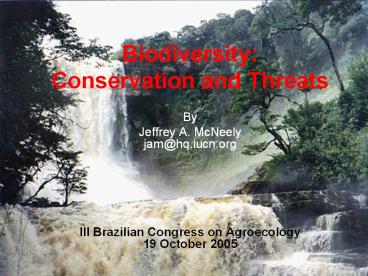Biodiversity: Conservation and Threats - PowerPoint PPT Presentation
1 / 43
Title:
Biodiversity: Conservation and Threats
Description:
Biodiversity: Conservation and Threats By Jeffrey A. McNeely jam_at_hq.iucn.org III Brazilian Congress on Agroecology 19 October 2005 For millions of years, the Americas ... – PowerPoint PPT presentation
Number of Views:4390
Avg rating:3.0/5.0
Title: Biodiversity: Conservation and Threats
1
Biodiversity Conservation and Threats
- By
- Jeffrey A. McNeelyjam_at_hq.iucn.org
- III Brazilian Congress on Agroecology19 October
2005
2
For millions of years, the Americas were
wilderness, left to wildlife
3
Once people arrived, things started to change
4
Fire and technology helped early human immigrants
into the Americas drive some species to
extinction, such as the mammoth, giant ground
sloth, and an entire complex of edentates. Our
lives are impoverished for having lost these
species.
5
But the hunting and gathering people who arrived
in the Americas also adapted, learning how to
conserve their natural resources in the
wilderness where they lived.
6
Agriculture developed independently in several
parts of the Western Hemisphere, giving people
greater control over nature, even domesticating
many species.
7
Later, mechanized agriculture -- often forced by
colonial or global sources of demand -- moved
across the land, replacing more wilderness,
further threatening wild biodiversity and
expanding the human population
8
We are consuming more food
- Resource Per capita increase
- (1950-1990)
- Grain 40
- Beef and mutton 26
- Fish 100
9
The process of land conversion continues to
accelerate, sometimes encroaching on legally
protected areas.
- This process continues to accelerate, threatening
even legally protected areas
10
Why do we need biodiversity?
11
Ecosystem Services the benefits people obtain
from ecosystems
- Regulating
- Benefits obtained from regulation of ecosystem
processes - climate regulation
- disease regulation
- flood regulation
Provisioning Goods produced or provided by
ecosystems food fresh water fuel wood
genetic resources
Cultural Non-material benefits from ecosystems
spiritual recreational aesthetic
inspirational educational
Supporting Services necessary for production of
other ecosystem services Soil formation
Nutrient cycling Primary production
12
(No Transcript)
13
FORESTS
- BENEFITS
- Absorption of carbon dioxide, a greenhouse gas
- Wood and other forest products
- Biodiversity drugs from plants
14
FORESTS
- Indicative costs if lost
- 7 million Likely cost to plant enough trees to
offset one million tons of carbon emitted
annually from a medium-size coal-fired power
plant. - 135 million Annual value of US and Canadian
maple syrup products. Pollution from midwestern
power plants threatens sugar maples in both
countries. - 1.6 billion Annual Sales of Taxol, an anticancer
agent first dervied from the bark of Pacific yew
trees.
15
GRASSLANDS
- BENEFITS
- Soil formation and retention
- Gene pool for crossbreeding grains
- Animal habitat
16
GRASSLANDS
- Indicative costs if lost
- 9 trillion Value today of 200 million tons of
topsoil blown off US Great Plains in one 1934
dust storm. Prairie had been ploughed to plant
wheat. - 14 million Annual value of Californias barley
crop Ethiopian wild barley genes provide virus
protection. - 256 million Kenyas annual tourism revenue.
Black rhinos, a major wildlife attraction, have
been poached nearly to extinction.
Source members.aol.com/ MVNick/snature.htm
17
OCEANS AND COASTS
- BENEFITS
- Major source of food protein
- Protection against coastal flooding and erosion
- Tourist and recreational revenue
18
OCEANS AND COASTS
- Indicative costs if lost
- 51 million Value of Canadas annual Atlantic cod
catch, down from 148 million in 1989. Catch fell
from 426,000 to 47,000 tons due to overfishing. - 100,000 Yearly cost to some Bali hotels to
combat beach erosion caused by destruction of
coral reefs. - 33,500 Annual value of a single shark to diving
industry in Maldive Islands value to a
fisherman 32.
19
Biodiversity includes wild relatives of domestic
plants and animals
20
Biodiversity can help ecosystems adapt to climate
change
21
(No Transcript)
22
The main threats to biodiversity
23
Rain forest burning
24
(No Transcript)
25
Where is the risk of extinction greatest? Areas
of threatened species richness
26
So what can be done to conserve biodiversity?
Protected areas provide one important answer.
27
The World Database on Protected Areas
Protected Areas in IUCN Categories I through VI
28
Key Problems Addressing the eternal conflict
between people and nature
29
Key ProblemsLand use change
30
Key Problems The increasing homogenization of
biodiversity how do we keep invasive alien
species out of wilderness areas?
31
Many people are working to find common ground
between farmers and biodiversity
32
So what options do we have for linking
biodiversity to agriculture?
33
1. Maintain non-domestic habitats within
production landscapes
34
2. Use economic incentives to encourage farmers
to conserve wild biodiversity
35
3. Compensate farmers for economic damage from
wild species
36
4. Recognize the value of traditional farming
systems to conserve domestic and wild biodiversity
37
5. Remove trade barriers to farmers in developing
countries
38
6. Apply modern technology to mainstreaming
biodiversity in agroecosystems
39
7. Recognize rights of farmers for genetic
resources
40
8. Recognize indigenous land rights for
biodiversity conservation
41
9. Use market instruments to support
agro-biodiversity
42
10. Adopt a landscape approach when mainstreaming
biodiversity
43
Conservation of biodiversity is an expression of
human culture. Biodiversity needs active
management if it is to provide us with the goods
and services we desire. This management needs to
include some areas where natural ecosystems are
enabled to continue their evolution. The
biological impacts of climate change will require
new approaches to conserving biodiversity.













![Eleanor McGregor [Director: Conservation] PowerPoint PPT Presentation](https://s3.amazonaws.com/images.powershow.com/8026054.th0.jpg?_=20160801045)

















